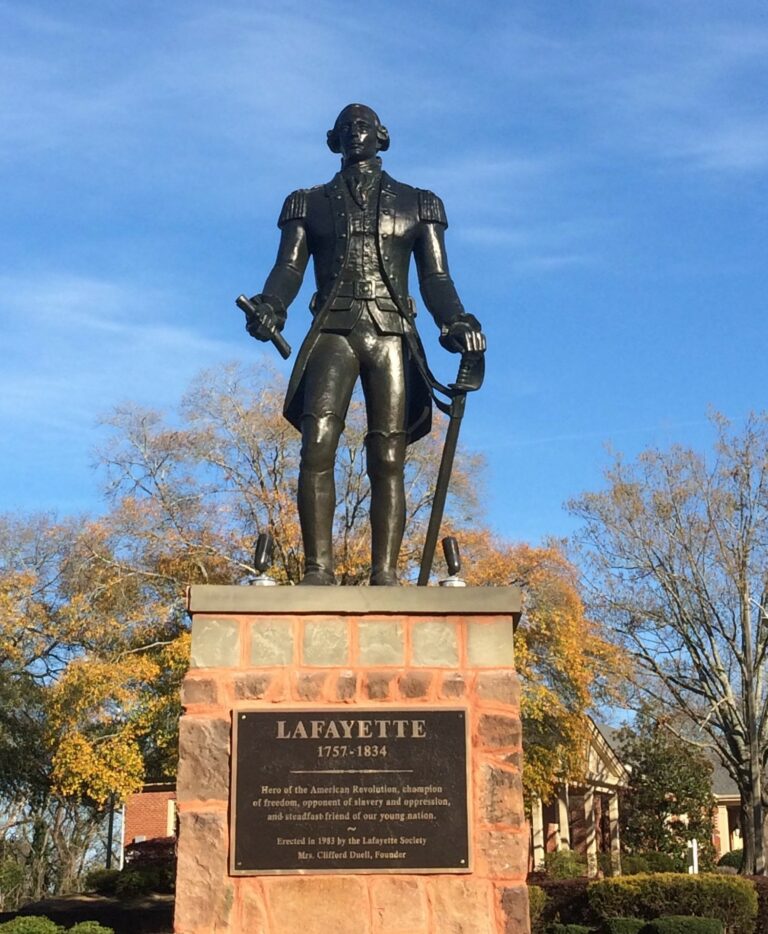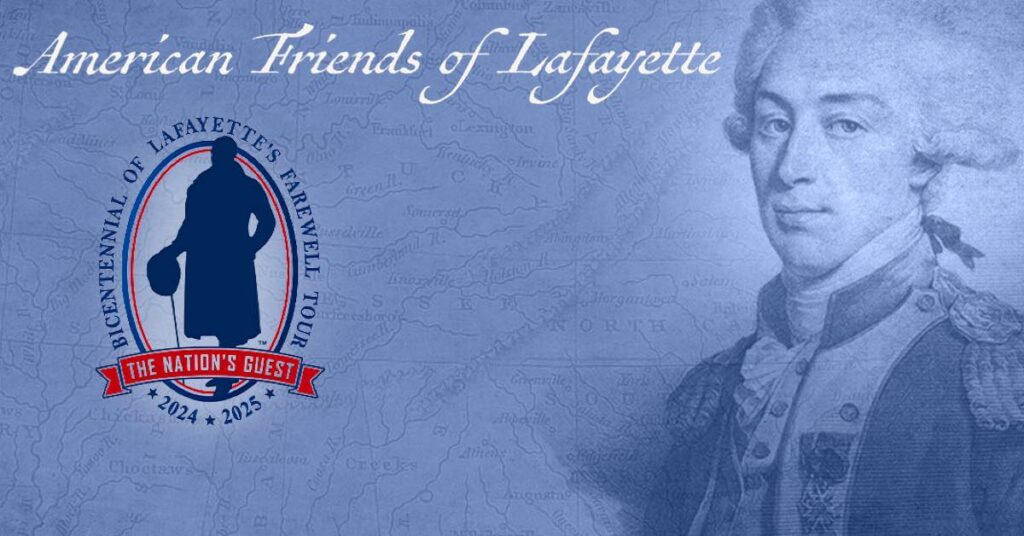In 2026, our nation will commemorate the 250th anniversary of the founding of the United States. It’s a huge event, but not the first of its kind. In 1824-1825, the country was about to celebrate America’s 50th and at the same time was hosting a 24-state, 13-month tour of the last surviving major general of the Continental Army, Gilbert du Motier, Marquis de Lafayette of France. During the tour, there were gatherings where speakers touted the recent accomplishments of America. It was a time of reflection and celebration in anticipation of America’s Jubilee year. Next year, American Friends of Lafayette will try to emulate this type of celebration, marking the 200th anniversary of Lafayette’s Farewell Tour of America.
In 2022, the American Friends of Lafayette received project grant funding from North Carolina Humanities to support their muti-faceted project entitled, “Bicentennial Commemoration of Lafayette’s 1824-1825 Farewell Tour Visits to Cities and Towns in NC.” The commemoration will include a national series of events as well as a web-based travelogue with 20 stops covering 9 cities and towns in North Carolina – including Fayetteville.
We connected with Alan Hoffman, president of the American Friends of Lafayette, to learn more about Lafayette’s time in North Carolina, the tour’s relevance to history, and Lafayette’s importance today.

Tell us about the American Friends of Lafayette!
Alan: We were formed in 1932 at Lafayette College by a small group of scholars and collectors. Today, we have over 800 members across the nation. We strive to educate the public about the life and legacy of Lafayette. We believe him to be not only a hero of the American Revolution, but a relentless human rights activist. We are currently engaged in a very ambitious series of programs to celebrate the bicentennial of Lafayette’s Farewell Tour, when he came back to the U.S as an elder statesman.
Who was Lafayette?
Alan: Lafayette was a young, wealthy nobleman in France who became inspired by the American Revolution. At 19, he was inspired to buy a ship, join the U.S Continental Army, and bring supplies and soldiers to America. Because of his wealth and zeal, he was able to negotiate a commission as a major general in the American army; that’s the second highest rank in the entire army. He arrived in America in June of 1777 and served as a volunteer without pay. After he recovered from being injured in battle in Pennsylvania, George Washington put him in charge of 3,000 Continental troops. After serving in several other battles in 1778, he went back to France on furlough in 1779, but rejoined the Continental Army in 1780. His most important military contribution was the Virginia campaign in 1781, an independent command which led to the siege of Yorktown and the British surrender there.
What about his role as a human rights advocate?
Alan: The reason that we at the American Friends of Lafayette are so enamored of Lafayette is because of his human rights record. He supported revolutions: the American Revolution, the French Revolution, the Spanish Revolution in the 1820s, the Polish Revolution in 1830, and South American revolutions. He saw nationalism as being a vehicle to promote human rights among all the people of a territory. He was a strong proponent of religious freedom, aiding the Protestants in France to gain more of their rights back. He was a supporter of prison reform, having served time in a European prison himself in the 1790s. He was a strong opponent of solitary confinement and the death penalty. In fact, in 1824, he visited Eastern State Penitentiary in Philadelphia where they were instituting a “reform” of a code of silence and lack of human contact. The authorities were proud of this, but Lafayette said something like, “You know gentlemen, you really have to have experienced solitary imprisonment to understand what it’s like…” He consistently opposed slavery. In the 1780s, he bought three plantations in Cayenne, French Guiana for the express purpose of helping them prepare for freedom. He hoped his experiment would serve as an example for others. He also joined three anti-slavery societies including one in England, one he helped form in France, and Alexander Hamilton’s Manumission Society in New York. Twelve years after Lafayette’s death, Thomas Clarkson, a British abolitionist, quoted Lafayette as saying, “I would never have drawn my sword in the cause of America had I known that thereby I was helping to found a land of slavery.”

What was “Lafayette’s Farewell Tour” and what relevance does it have for audiences today?
Alan: Lafayette came back to America on the invitation of James Monroe, and at 67 years old, he traveled the entire country, which at the time was 24 states. His 13-month visit is one of the reasons why there are so many streets, towns, parks, and other landmarks named after him. In 1824 when he arrived, there were only three places named for him: Fayette County in Kentucky, Fayette County in Pennsylvania, and of course, Fayetteville, North Carolina. Fayetteville was the first town named for Lafayette. The Farewell Tour is now referred to as such because it was the last time Lafayette would visit America before his death. His visit was just before America’s 50th and it became a way for Americans to look back, celebrate their successes, and feel good about themselves. In every state he visited, there were gatherings in which speakers would comment about the success of America with respect to population growth, public education, commerce, trade, agriculture, and the arts. This project, funded in part by North Carolina Humanities, is designed to replicate the same effect for today’s Americans. We see these upcoming commemoration events as a prelude to America250 and a way for people to celebrate America and its diversity today.
Tell us about the project:
Alan: We are working with a company called TravelStorysGPS to compile 20 stories about stops that Lafayette made in North Carolina during his Farewell Tour. Each story is about 3 minutes long and shows images associated with the stories. If you visit the sites in person and have the app open, the story triggers as you walk along the designated tour-stop path. The first story is in Murfreesboro. We will also have three separate stories for his stops in Raleigh. Fayetteville is quite important because he spent the most time there of any town in North Carolina. To our knowledge, he passed through North Carolina when he first arrived in America as a young man, and at that time, Fayetteville had a different name, Campbellton. However, the people decided to change the name to Fayetteville in 1783. We will feature ten different stories about Lafayette’s time in Fayetteville, with one of them being about the name change. In conjunction with the travelogue, we are also currently planning several events in Fayetteville. We’re very grateful for the support of North Carolina Humanities. Thanks also for the support of the North Carolina Society of the Cincinnati and the Lafayette Society of Fayetteville. The Lafayette Society’s Hank Parfitt and Mike Samperton and North Carolina native Frank Womble assisted in writing the stories. I also want to thank Mark Schneider, who is a Lafayette interpreter and the narrator of Lafayette’s quotations in our stories; our TravelStorys editor Liz Prax; and of course, Professor Lloyd Kramer of the University of North Carolina, who is a Lafayette scholar and friend. North Carolina Humanities and so many others are helping make this project a success. We expect to launch the travelogue in Fayetteville in March.
How can people get involved and support American Friends of Lafayette?
Alan: You can visit friendsoflafayette.org to learn more about our work and Lafayette200.org to learn about our plans for the Bicentennial. All members receive The Gazette of The American Friends of Lafayette and regular updates about our work across the nation. We hope you will stay connected and celebrate with us in 2024-2025.
About North Carolina Humanities’ Grantee Spotlights: NC Humanities’ Grantee Spotlights shine a light on the incredible work of our grantee partners, offering details about their funded project, and feature a Q&A with a team member(s) associated with the organization. This interview has been edited for length and clarity.


